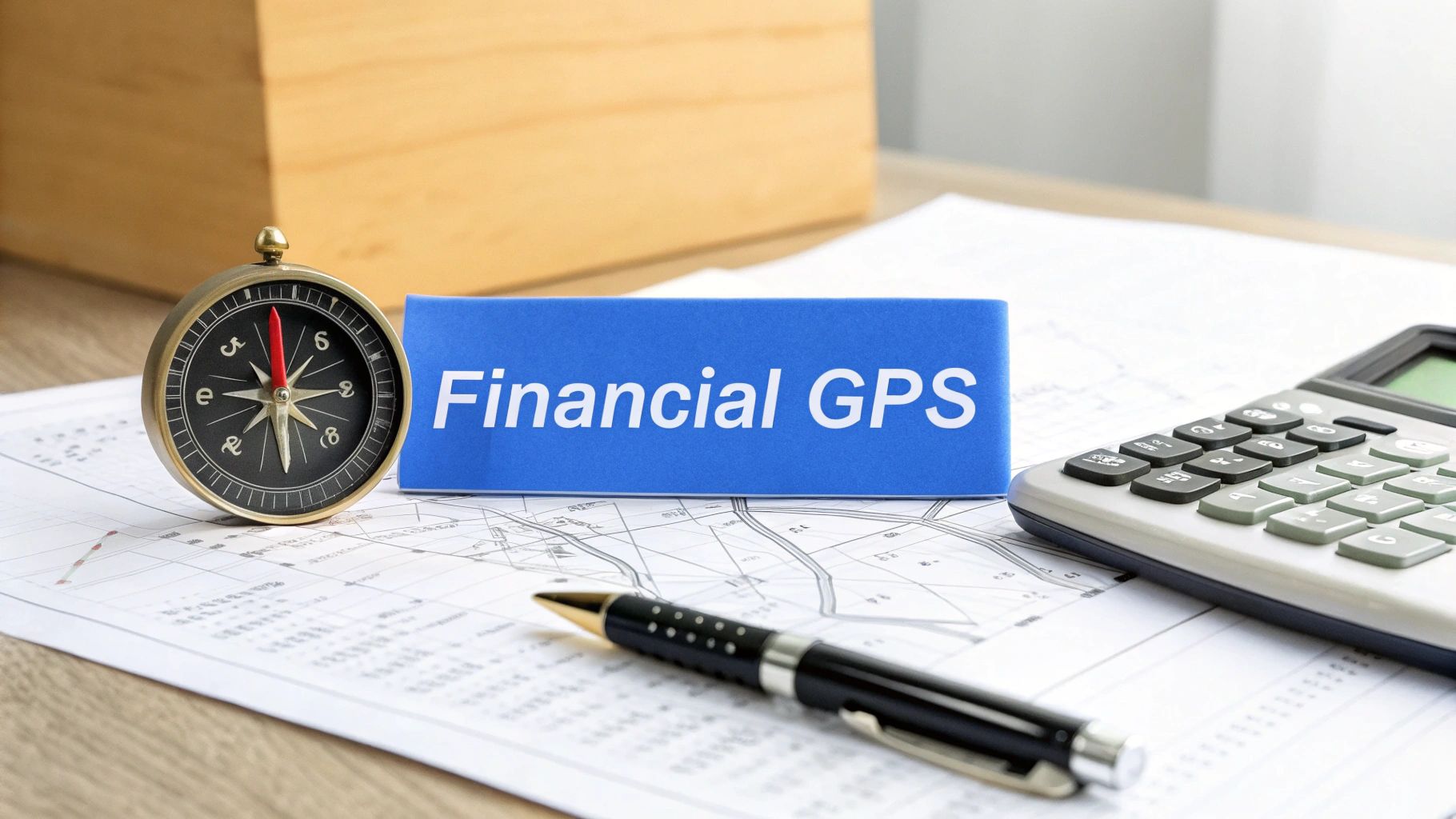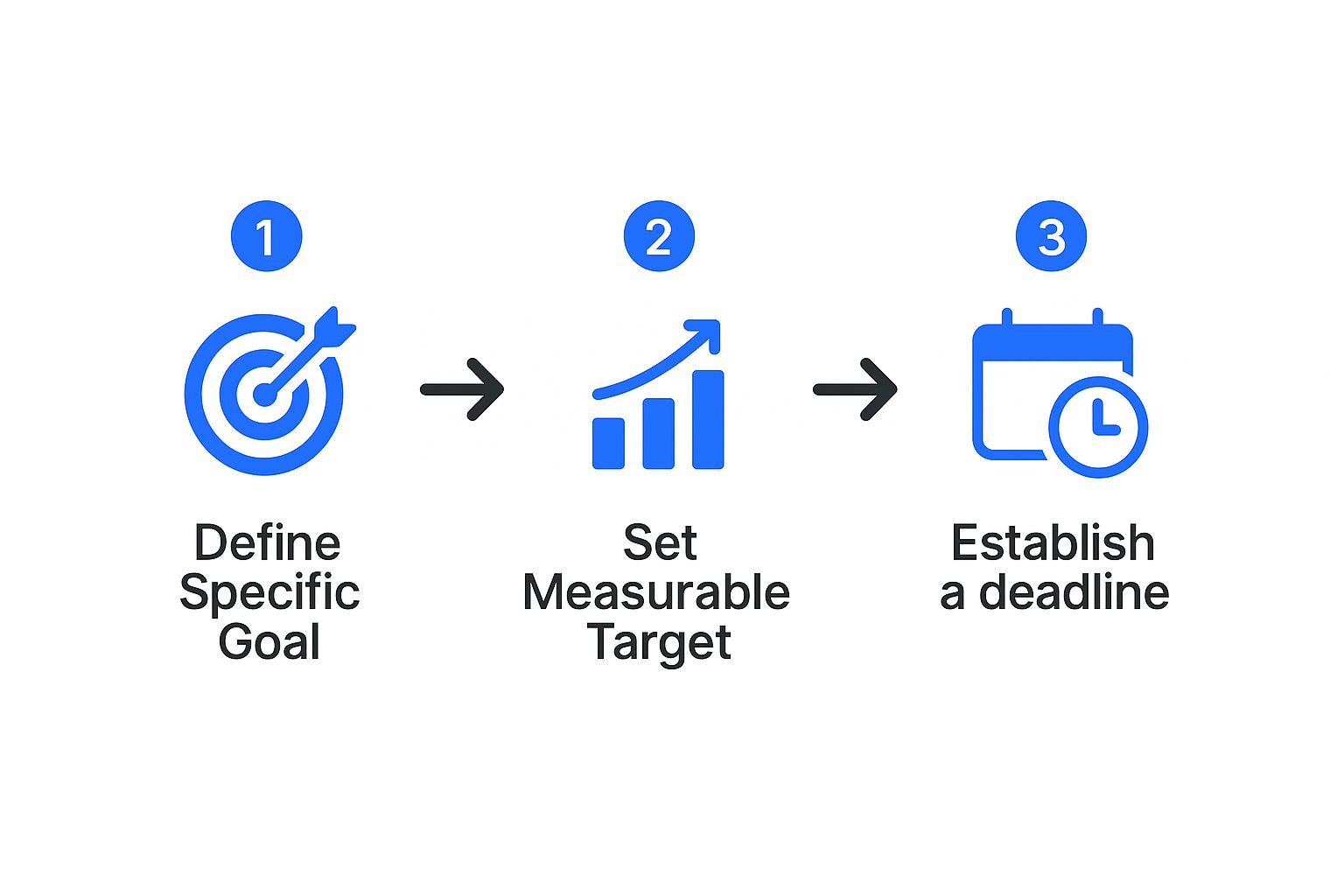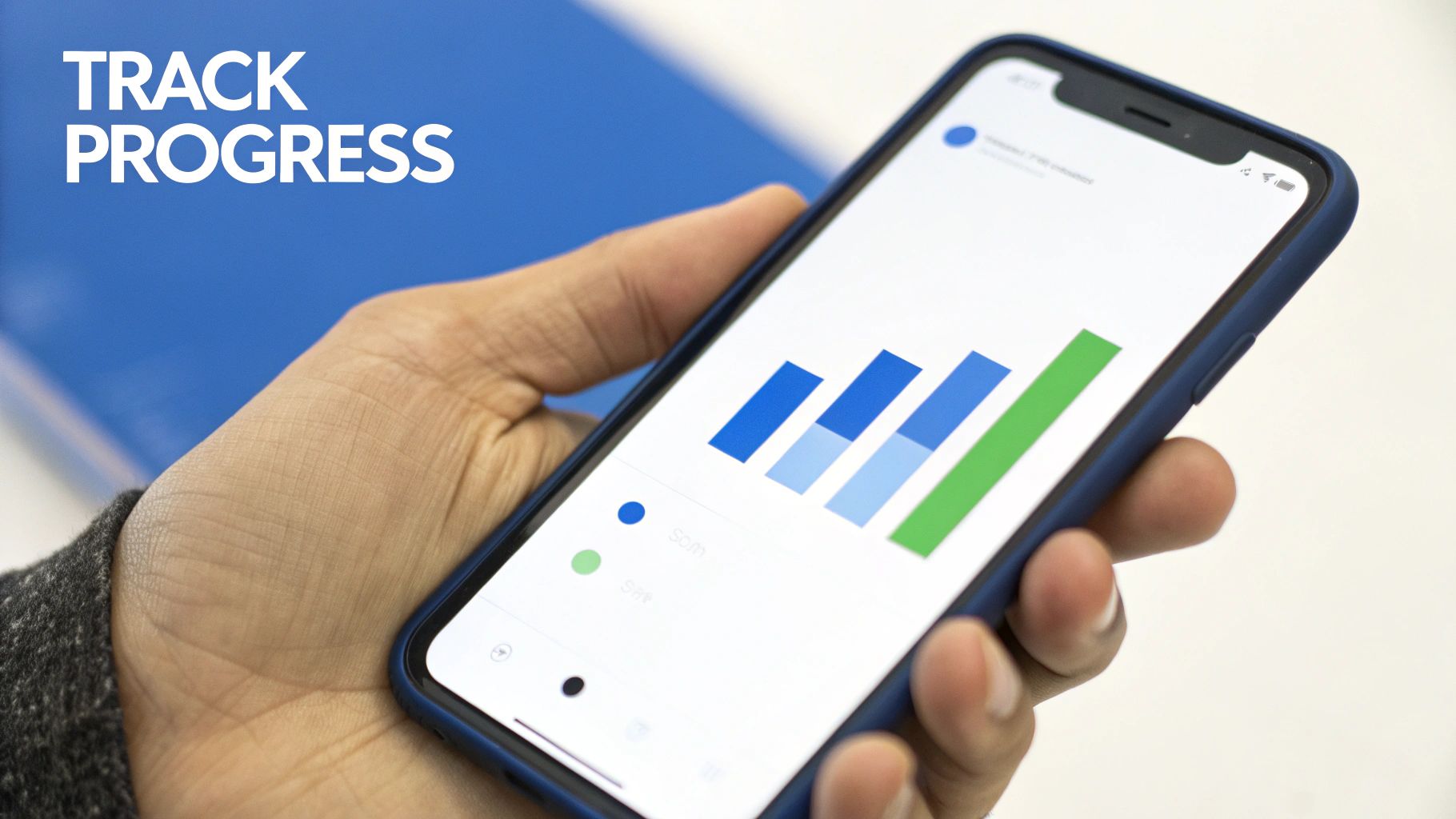Our Marketing Team at PopaDex
Master Financial Goal Setting for Your Wealth Journey

Financial goal setting is just a fancy term for giving your money a job to do. It’s about creating a roadmap that turns vague dreams like “I want to be rich” into concrete, achievable steps. This is the single biggest difference between drifting through your financial life and being in the driver’s seat.
Your Financial GPS for Lasting Success
Ever tried to drive to a new city without a map or GPS? You probably wandered around, burned a lot of gas, and maybe never even got to where you were going. Your financial life works the same way. Without clear goals, your money has no direction. It’s easy to fall into a cycle of impulse buys, missed opportunities, and that nagging feeling that you’re just financially adrift.
Think of financial goal setting as your personal GPS for money. It gives you the clarity and structure you need to navigate your financial journey with real purpose. It’s about moving beyond just wishing for a better financial future and actually building one.
The Power of a Written Plan
Lots of people have financial hopes, but very few actually write them down. This is a huge mistake.
Writing down your goals makes them real. It forces you to get specific, turning fuzzy ideas into solid targets. It’s the difference between saying, “I’ll try to save more this year,” and committing to, “I will save $5,000 for a down payment by December 31st.” That documented plan becomes a constant reminder of what you’re working for, keeping you motivated when things get tough.
Why Most People Drift Financially
So, if the benefits are so obvious, why do so many people operate without a financial roadmap? It’s not usually because they don’t want to succeed. More often, they just feel overwhelmed or believe they don’t have enough money to even start.
The reality is, a financial plan isn’t just for the wealthy; it’s a tool for building wealth, no matter your starting point. It provides direction and turns your income, whatever its size, into a powerful engine for progress.
The numbers back this up. In the U.S., only 36% of Americans have a documented, long-term financial plan. Even more concerning, 27% have no emergency savings at all. A major reason people gave for not having a plan? A staggering 43% said they felt they didn’t have enough money—the very problem a plan is designed to solve. You can dig into more personal finance statistics to see the full picture.
This data points to a massive vulnerability for millions. Without a plan, it’s nearly impossible to handle emergencies, invest for the future, or make choices that align with what you truly want in life. Financial goal setting is how you break that cycle. It gives you:
- Direction: Your goals tell your money where to go, stopping it from vanishing into unplanned expenses.
- Motivation: Watching yourself get closer to a meaningful goal—like becoming debt-free or securing a comfortable retirement—is an incredible motivator.
- A Decision-Making Framework: When you’re faced with a spending decision, you can simply ask, “Does this move me closer to my goals?” This one question makes financial choices easier and dramatically cuts down on stress.
Map Your Current Financial Landscape

Before you can chart a course to your financial destination, you have to know exactly where you’re starting from. Real, effective goal-setting doesn’t begin with dreaming—it begins with an honest look at where you stand today. This isn’t about judging past mistakes; it’s about getting clear, objective data to make smarter decisions going forward.
Think of it like finding the “You Are Here” dot on a giant map. Without that crucial marker, any route you plan is just a shot in the dark. By creating a detailed snapshot of your current finances, you build the solid foundation for every successful goal. It’s the first and most critical step.
Calculate Your Net Worth
Your net worth is the single best snapshot of your financial health. The formula is refreshingly simple: it’s everything you own (assets) minus everything you owe (liabilities). Calculating it gives you a clean, high-level number that shows your financial position at this very moment.
- Assets are things like the cash in your bank accounts, your retirement fund balances, investment portfolios, the current market value of your home, and other valuable property.
- Liabilities cover your mortgage balance, student loans, credit card debt, car loans, and any other money you owe.
Subtract your total liabilities from your total assets, and you’ve got your net worth. This number becomes a powerful baseline you can track over time to see the real-world impact of your efforts.
Understand Your Cash Flow
While net worth gives you the big picture, cash flow—the money moving in and out of your accounts each month—is where the magic happens day-to-day. This is where you get granular and find out exactly where your money is going.
First, add up all your income sources after taxes. This means your salary, any side hustle money, or other regular cash infusions. Next, and this is key, diligently track all your expenses for at least one full month. Group them into categories so you can see your spending habits clearly.
So many of us make the mistake of relying on memory or just guessing. The reality of where your money goes, once you write it all down, can be a real eye-opener. This isn’t about creating a restrictive budget; it’s about gaining awareness. You can’t redirect your money toward your goals if you don’t know where it’s flowing right now.
This exercise often exposes “spending leaks”—those small, frequent purchases that add up to a surprising amount over time. The goal isn’t to cut out all the fun, but to make conscious choices that align your spending with what you truly value. To get a better handle on this, you might explore market salary research to see how your income potential lines up with your financial goals.
Acknowledge Broader Economic Factors
Your personal finances don’t exist in a bubble. Bigger economic trends absolutely influence your ability to hit your goals. For example, a recent report pegged the global financial health score at a stable 55, reflecting a mix of economic pressures and positive new habits. It also noted a real improvement in financial learning and planning—which is exactly what we’re talking about here.
In North America, this progress is happening alongside a strong job market, but it’s also being challenged by rising household debt. You can dig into more of these insights from the latest report on global financial health.
Understanding these trends helps you set more realistic expectations. If interest rates are high, maybe paying down variable-rate debt should jump to the top of your list. If the job market is strong, it could be the perfect time to aim for a higher income. This awareness lets you adapt your strategy, making your financial plan more resilient. When you map your personal data against the larger economic context, you’re truly equipped to set goals that are both ambitious and grounded in reality.
Use the SMART Framework for Powerful Goals
Let’s be honest. Vague wishes like “I want to save more” or “I need to be better with money” are set up to fail from the start. They feel good to say, but they don’t give you any direction. They lack the clear, sharp edges needed to actually make something happen.
To turn those fuzzy daydreams into real, achievable targets, you need a framework. The most trusted and effective method out there is the SMART framework. It’s not just a catchy acronym; it’s a filter that transforms a passive wish into an active, concrete plan. A well-defined SMART goal stops being a source of stress and becomes a clear, motivating roadmap that tells you exactly what to do next.
Defining Your Specific Target
First things first: you have to get crystal clear on what you actually want to accomplish. The “S” in SMART stands for Specific, and it means leaving zero room for doubt. Vague goals are easy to ignore because they don’t create a real picture in your mind.
For instance, “save for a vacation” is a nice thought, but it’s flimsy. A Specific goal sounds like this: “Save for a 10-day trip to Italy.” See the difference? That clarity instantly makes the goal feel more real and gives you something tangible to chase.
Making Your Goal Measurable
Next, if you can’t measure it, you can’t manage it. A Measurable goal answers the big questions: “How much?” or “How many?” This is absolutely critical for staying motivated because it lets you see the small wins stacking up along the way.
Let’s build on our vacation goal. To make it Measurable, we need to add a dollar amount: “Save $6,000 for a 10-day trip to Italy.” Now we have a finish line. Without that number, you’d never know if you actually succeeded.
The image below shows how this simple shift turns a vague idea into something you can actually work with.

This visual gets right to the point: you have to move from a general concept to a specific, quantifiable objective with a clear deadline. Those are the pillars of the SMART framework.
Ensuring Your Goal Is Achievable
A goal should stretch you, but it shouldn’t be so out of reach that it feels like a fantasy. This is the “Achievable” part of the equation. Setting a goal to save $1 million in one year on a $50,000 salary isn’t just ambitious—it’s completely demoralizing.
An Achievable goal respects your current reality, factoring in your income, expenses, and other commitments. If your budget shows you can realistically set aside $500 a month, then saving $6,000 in a year is a challenging but totally doable target. This keeps you in the game instead of setting you up for failure.
Keeping It Relevant
Your goals have to matter to you. The “Relevant” test asks a simple question: “Why am I doing this?” A goal that connects with your deeper values and other life plans is one you’re far more likely to see through to the end.
For example, if you’re also trying to aggressively pay down high-interest debt, taking on a new savings goal for a luxury car might not be Relevant right now. But if that trip to Italy is to celebrate a huge life milestone, its relevance will give you the emotional fuel to stay committed when things get tough.
Setting a Time-Bound Deadline
Finally, every goal needs a finish line. The “Time-bound” element creates a healthy sense of urgency and puts a stop to procrastination. A goal without a deadline is just a dream that you can keep putting off until “someday.”
Let’s complete our example: “Save $6,000 for a 10-day trip to Italy by contributing $500 per month for the next 12 months.” And there it is—a complete SMART goal. It’s specific, measurable, achievable, relevant, and has a clear timeline.
This is how you turn an idea into a plan. To see how this works with other common financial wishes, check out the table below.
Transforming Vague Wishes into SMART Financial Goals
This table shows how you can apply the SMART framework to turn common financial hopes into actionable, trackable goals.
| Vague Wish | SMART Goal | Breakdown (S, M, A, R, T) |
|---|---|---|
| “I want to buy a house.” | “I will save $40,000 for a down payment on a house in my target neighborhood by saving $833 per month for the next 4 years.” | S: Save for a down payment on a house in a specific area. M: $40,000 total, $833/month. A: Based on my current income and budget. R: Owning a home is my top priority. T: 4 years. |
| “I need to pay off debt.” | “I will pay off my $8,000 credit card balance in 20 months by making extra payments of $400 each month.” | S: Pay off one specific credit card. M: $8,000 balance, $400/month. A: My budget allows for this extra payment. R: Becoming debt-free will reduce my stress. T: 20 months. |
| “I should invest more.” | “I will open a Roth IRA and contribute $250 per month, aiming to reach a $3,000 balance in the first year.” | S: Open a Roth IRA and contribute a set amount. M: $250/month, $3,000 yearly target. A: $250 fits within my monthly savings plan. R: I want to start building long-term wealth for retirement. T: 1 year for the initial balance goal. |
As you can see, the SMART structure adds the necessary detail to make any financial goal feel real and within reach.
Ready to build your own? You can start right now by downloading our free financial goal setting worksheet to guide you through each step.
Prioritize Your Short, Mid, and Long-Term Goals

Alright, you’ve defined your goals and they’re looking sharp. The temptation now is to jump in and start chasing all of them at once. It’s a classic mistake, and frankly, a recipe for burnout.
Effective financial planning isn’t just about what you want; it’s about the order you do things in. Juggling too many goals at the same time just means you end up overwhelmed, making little progress on any of them.
Think of your income as a finite resource, like a bucket of water. If you try to water a dozen plants at once, none of them get enough to thrive. The key is to give the thirstiest plants a good soak first, then move on to the others. That’s why sorting and prioritizing your goals is absolutely critical.
Sorting Goals by Time Horizon
The simplest way to bring order to the chaos is to sort your goals into three buckets based on their timeline. This one move brings incredible clarity, showing you what needs your attention now and what requires a more patient, long-game approach.
- Short-Term Goals (1-3 Years): These are your immediate priorities. Think of them as building your financial foundation—without a solid base, everything else you build is at risk.
- Mid-Term Goals (3-10 Years): This is where major life upgrades live. These are the big-ticket items that need dedicated, multi-year saving efforts. They bridge the gap between today’s needs and tomorrow’s dreams.
- Long-Term Goals (10+ Years): Here lie your biggest ambitions, the ones that often take decades of consistent work to achieve. Patience and the magic of compounding are your best friends here.
By categorizing your goals this way, you turn a messy wish list into a clear, step-by-step roadmap. It helps you point your money where it needs to go, ensuring you’re moving forward on all fronts without getting overwhelmed.
Real-World Examples of Goal Tiers
Let’s ground this in reality. Here’s what these tiers might look like in your own life.
Short-Term Goal Example: Your number one job is to build a $5,000 emergency fund. This is non-negotiable. It’s the financial firewall that protects all your other goals from getting torched by an unexpected expense, like a busted transmission or a surprise medical bill.
Mid-Term Goal Example: You’ve got your eye on a new car and want to save $25,000 for a down payment over the next five years. This calls for a consistent savings plan but doesn’t have the same life-or-death urgency as your emergency fund.
Long-Term Goal Example: The big one: a comfortable retirement. This means making steady contributions to your investment accounts for the next 25+ years to build a nest egg that will support you later in life. Buying a home is another common long-term goal. When you’re ready to start on that journey, it’s vital to understand the different types of mortgage loans available to make a smart choice.
The Critical Role of Prioritization
Just sorting your goals isn’t quite enough. You have to decide which ones get first dibs on your paycheck. Your goals are all competing for the same dollars, and this is where you have to make some tough but necessary choices. For most people, one priority towers above the rest: crushing high-interest debt.
High-interest debt, like credit card balances, is like a leak in your financial boat. It doesn’t matter how hard you row (save and invest); that leak is constantly working against you, slowing you down and threatening to sink your entire plan.
It seems a lot of people are getting the message. A recent GOBankingRates survey found that nearly 33% of Americans named paying off debt as their top financial priority. That’s more than double the number focused on saving for an emergency (15%) or investing for retirement (13%).
This shift shows a smart understanding that getting rid of expensive debt is the first real step toward financial freedom. By structuring your goals and prioritizing with intention, you create a balanced plan that takes care of today while actively building the future you want.
Track Your Progress and Stay Motivated

Think of it this way: setting powerful financial goals is like plugging a destination into your GPS. But what good is a map if you never glance at it during the drive? That’s where consistent tracking comes in. It’s what turns your plan from a piece of paper into a living, breathing guide that actually gets you to the finish line.
This isn’t just about crunching numbers. It’s about staying engaged. It’s a lot like a fitness app showing your daily steps—seeing that progress bar inch forward, even a little, gives you a small win that keeps you going. Financial tracking does the exact same thing. It makes the abstract concept of “saving more” feel real, tangible, and motivating.
Choose Your Tracking Method
There’s no one-size-fits-all way to monitor your money. The best method is whichever one you’ll actually stick with. You just need a system that fits your style and doesn’t feel like a chore. The point is to get a clear, at-a-glance view of how far you’ve come and what’s left to tackle.
Here are a few popular routes you can take:
- Simple Spreadsheets: A classic for a reason. Tools like Google Sheets or Excel are free, completely customizable, and put you in the driver’s seat. You can build your own charts to watch your debt disappear or your savings pile up.
- Dedicated Financial Apps: Platforms like PopaDex are built for this. They often sync with your accounts automatically, giving you a real-time snapshot of your entire financial world without the headache of manual entry.
- The Analog Approach: Don’t underestimate the power of pen and paper. For some, a physical notebook or a chart on the wall can be incredibly motivating. There’s a special kind of satisfaction in coloring in a square for every $100 you save.
No matter what you pick, the habit is what counts. Set a recurring date with yourself—weekly, bi-weekly, monthly—to sit down and see where you stand. This regular check-in is a fundamental part of creating a financial plan that can adapt and actually work long-term.
Celebrate Milestones and Adapt to Setbacks
The journey to a major financial goal can be a long one, and it’s easy to lose steam. That’s why it’s so important to celebrate the small wins along the way. Did you save your first $1,000 for that down payment? Pop a little bottle of something. Paid off a credit card? That deserves a victory lap. These mini-celebrations are fuel for your motivation.
A financial plan isn’t carved in stone; it’s a flexible roadmap. Life happens. An unexpected car repair or a surprise bill isn’t a failure—it’s just a detour. A good plan is designed to absorb these shocks without completely derailing you.
When a setback hits, don’t throw in the towel. Take a breath and look at your plan. You might need to pause contributions to one goal to handle the immediate need, or maybe just adjust your timeline. The key is to acknowledge it, adjust your course, and get back on track as soon as you can. That resilience is what separates people who reach their goals from those who give up at the first sign of trouble.
Answering Your Financial Goal Setting Questions
Even the best-laid financial plans run into questions. That’s not a sign of failure—it’s a normal part of the process. Facing these common hurdles head-on is how you build real financial confidence and keep your momentum going.
Let’s walk through some of the most frequent sticking points people face when setting their goals. Think of this as your personal troubleshooting guide to get you back on track.
How Do I Start With a Low Income?
It’s easy to feel discouraged when you’re trying to set financial goals on a tight budget, but this is actually when it’s most important. The trick is to shift your mindset from big dollar amounts to consistent, small habits. The first step is always to get a clear picture of where your money is going. Track your spending for a month and you’ll be surprised by the small “leaks” you can plug.
Even saving $20 a week can be a game-changer. It builds the crucial habit of paying yourself first and proves that you can make progress. Your first big win should be creating a small emergency fund. This buffer provides incredible peace of mind and stops a small hiccup from turning into a major crisis, a foundational idea we cover in our guide to financial planning for beginners.
Should I Save or Pay Off Debt First?
This is the classic chicken-or-the-egg financial dilemma. The truth is, it’s rarely an either/or situation. The most effective strategy is usually a hybrid approach that tackles both at the same time. High-interest debt, like a nagging credit card balance, is a five-alarm fire; the interest is actively working against you every single day. But having zero savings makes you incredibly vulnerable to life’s curveballs.
Here’s a balanced way to approach it:
- Build a small starter emergency fund. Aim for something like $1,000. This is your financial shield.
- Go scorched-earth on high-interest debt. Throw every extra dollar you have at it while making only minimum payments on lower-interest loans (like a mortgage or student loan).
- Once the nasty debt is gone, pivot. Redirect all that money toward fully funding your emergency savings (3-6 months of essential expenses) and then start crushing your other savings goals.
How Often Should I Review My Goals?
Your financial goals aren’t carved in stone. They need to breathe and adapt as your life changes. A good rhythm is a quick monthly check-in—just a few minutes to make sure your spending is aligned with your goals. Then, schedule a deeper dive every six months or at least once a year to review the big picture.
A major life event—like a new job, a promotion, getting married, or having a child—should always trigger an immediate and thorough review of your entire financial plan. Your goals are only useful if they’re relevant to the life you’re living today.
What if I Keep Failing to Meet My Goals?
If you keep missing your targets, it doesn’t mean you’ve failed. It means your plan needs a tune-up. The first place to look is the goal itself. Is it truly a SMART goal? More often than not, the goal is just too big or too vague.
Break it down into smaller, less intimidating pieces. Struggling to save $500 a month? Try reframing it as $125 a week. That simple change can make it feel much more achievable. If that’s still a stretch, dial it back even further. Progress, not perfection, is the name of the game. It’s far better to start small and build momentum with wins than to aim too high, get discouraged, and quit.